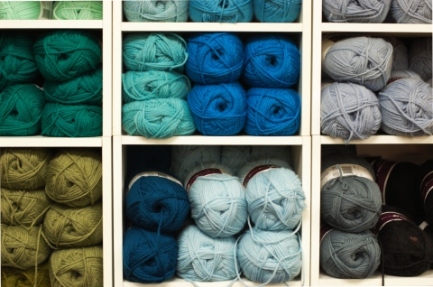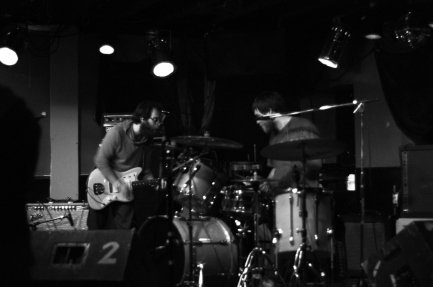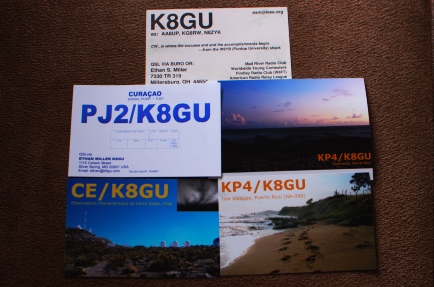This is going to be short with a few pictures. The schematics will follow once I get things into a final form. As anyone who follows the blog knows, I have recently acquired a VHF habit. I have endeavored to do this at reasonable cost. Thus, the “transverters” series begins…
One of the first things Dad won at a hamfest after we got licensed was the 1993 ARRL Handbook. Between us, we’ve read the thing cover-to-cover a few times. OK, that was mostly me. I ended up swiping it at some point a few years ago and I still read it now and then. One of the objects of my interest since the very beginning has been the chapter full of VHF projects. I was always frustrated as a new ham that the 6-meter transmitting converter article was not a complete transverter. This is my story of building a 6-meter transverter based on the transmitting converter in the 1993 ARRL Handbook.
The Handbook calls for a 22-MHz LO, resulting in a 28-MHz IF. I elected a 24-MHz LO using an inexpensive (< $1) computer crystal instead of the $15-$25 custom crystal. We’re talking most of the cost of the project going into the crystal. The 24-MHz LO put the IF at 26 MHz. For the non-engineer (or non-ham) readers who’ve made it this far, this is just arithmetic: 22+28=24+26=50. 26 MHz (28 MHz) is the frequency to which we are tuning our existing receiver, 50 MHz is where we wish to receive, and 24 MHz (22 MHz) is the oscillator frequency we need to mix with the 50 MHz signal make it show up at our receiver (26 or 28 MHz). The designs are functionally equivalent except for some tighter filtering requirements when the IF and LO move closer together. No big deal for this design, though.
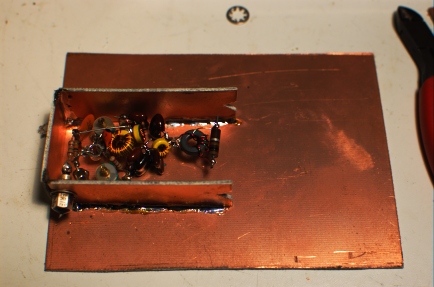
After noting two important failures in the wiring (before the walls in the photo above were installed), the oscillator jumped to life and I tuned it for maximum smoke (peaked it).
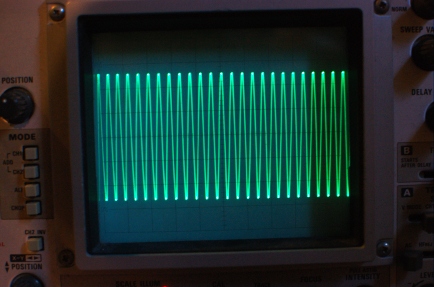
As an aside, this picture reminds me that if I had a modern digital oscilloscope, I could have a soft copy saved to insert into this post. Ah, analog!
While the LO chain was straight out of the ARRL Handbook, except for the 24-MHz crystal, the RX strip was completely of my design. I don’t have the schematic in electronic (or paper, for that matter) form, yet. But, it consists of a 2-resonator preselector filter (lifted from Experimental Methods in RF Design), a TUF-3 diode ring mixer, and a diplexer mixer IF-side termination (from the 144-/220-MHz transverter article in the same edition of the Handbook). I had an SGA4586 MMIC amplifier board soldered-up from another project; so, I tacked that on the front end. This final step was mostly because I was in a hurry to meet the weekly landline sked with my folks.
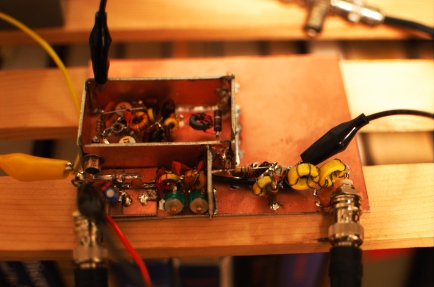
I hooked the whole mess up to my 10-meter dipole and FT-840 to have my first tune about 6 meters. The preamp did not appear to work, so I shunted it. (This was not surprising since I just found it on my bench in some unknown and unrecorded state. Plan to build something better.) Last night, thunderstorms were in the area, so I didn’t want to leave it connected for long. I had cleverly shunted both the preamp and the preselector, so I was getting a fair bit of static crashes from the 2 MHz image, as well. But, I heard the W3APL beacon on 50.064 (actually 26.0725…the LO is not exactly on 24.000 MHz).
This morning, I realized my error and put the preselector in line, shunting only the preamp. I peaked the preselector on the beacon signal. It is handy to have a local beacon. If I ever live somewhere without them, I think I’d almost just install a set of them for the sole purpose of helping experimenters align their gear with minimal test equipment. Although, the HP8640B is reasonably-priced, even with option 002. Should probably pick one up at some point.
More on this adventure to follow…
